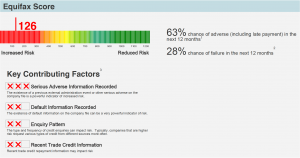01 Feb How is my credit score calculated (part 3)
Usually if you are asking this question, it is kind of too late. The best thing to do is to stay on top of it in the first place.
If you do want a copy of your credit report, go to Equifax. Any other provider is basically a waste of time.
I always used to find it funny that no one ever asks you if you want them to create a credit file for you.
And then, when you want a copy of it you have to pay. But anyway, that’s just how the world works I guess.
Most of the time you can qualify for a free credit report anyway, and to be honest buying it isn’t that expensive.
If you are too far gone and need something removed, your options are pretty limited.
There are companies out there that claim they can do this for a fee. I’ve heard of plenty of people losing their money with these people, so I would stay away from these dark arts.
Accounts and repayments issues will sort themselves out in 2 years if you have good repayment history. You don’t really have any other option here, as credit providers will not lie about your repayment history.
Court actions aren’t going away either. You just have to wait the 5 years until they fall off your credit file.
Court writs shouldn’t stay there if you’ve had a judgement. If it’s there and it shouldn’t be, you should call the court you visited and ask them for a judgement letter. Providing this to Equifax will solve your problems.
The only item that you may have luck with is defaults.
First off, check that the company has followed all the appropriate steps before listing a default on your file. Steps are below.
- Credit provider must have attempted to make contact with the individual by phone, email and mail (where possible).
- If these attempts suggest contact details are no longer current, take reasonable steps to ascertain new contact details. If obtained repeat attempts to make contact.
- Take reasonable steps to provide contact details – email or phone messages left with an answering machine or an adult. Ask the individual to contact the credit provider as a matter of urgency.
- In the case of mail – provide particulars of default and state that if a period of 6 months elapses with no contact with the individual about the default the credit provider intends to disclose the default as an serious credit infringement to a credit reporting bureau . Explain the effect of this.
- If the individual makes contact any time during the 6 month period, the 6 month period recommences.
Be honest with yourself, if they have followed these steps. Then your best option is to make sure it’s paid. And to make sure the default is listed as paid.
Credit providers are notorious for not listing defaults as paid. It’s not an ideal scenario, but a paid default is definitely better than an outstanding default.
Now you might say, being “paid” is not enough. I want it off my file!
Even though they are not supposed to, companies will sometimes remove defaults for an “annoying” customer. So complain, complain, complain.
It’ll take you multiple phone calls, that might last hours, but it might just work.


Sorry, the comment form is closed at this time.